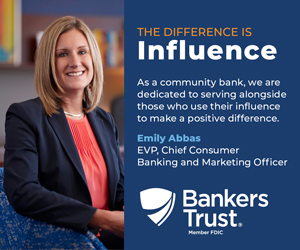A Closer Look: Carl Gordulic
Chief financial officer, Involta

Acquisitions have been a common occurrence during Carl Gordulic’s career.
Based in Youngstown, Ohio, he started as chief financial officer for Cedar Rapids-based Involta in January following the acquisition of Involta by Carlyle Group in February 2022. The data center and IT services provider was previously owned by private equity firm M/C Partners.
Gordulic moved away from manufacturing and into the technology sector in 2008, becoming CFO for a small but growing company in Youngstown called DRS. He contributed his financial and business background and served as president of the organization as well before it was acquired by Involta in 2015.
Gordulic said the deal triggered the start of a collaboration that has been successful for both parties. His initial role with Involta was integrating and streamlining the two companies’ financial operations, reducing the number of disparate systems from 10 to three in about three years. In 2022, he was promoted to senior vice president of finance.
We recently caught up with Gordulic.
This Q&A has been lightly edited and condensed for clarity.
How did Involta’s acquisition by Carlyle come about?
At the time, Involta was owned by another private equity firm for six or seven years so we were at the end of the life cycle of that fund. We had done two new builds in 2017 and we were on hold for a little period of time there to really get new capital to invest to continue the growth. We expanded pretty heavily over here in northeast Ohio. We also expanded our Boise facility a couple of years ago. We really were at the point of looking for a new partner to help spur the next step of Involta’s growth. We got introduced to Carlyle and it was honestly, in my experience, probably one of the quicker transactions from introduction to close. We were really impressed with their process, their due diligence, their decision-making ability and ability to get a deal done. I want to say it was about six months from initial meeting to actually closing the deal. A lot of times it’s six months just to have a few meetings. Carlyle brought the funding behind them to Involta and the ability to look at where we want to go next with potentially expanding our data center or looking to new markets, so it really opened back up the growth aspect of what we do here.
Where will Involta’s short-term growth be focused moving forward?
Involta traditionally focuses on the tier-two markets because we’re not going to be in Chicago or Arlington, Va. Right now we’re in Cleveland, Youngstown, Canton and Akron, that kind of triangle. For a metropolitan area, that look is probably other markets that we would like to emulate. Probably on the Boise, Cleveland end of the scale is where we’re looking for similar markets. We’re heavily focused in the health care, manufacturing and finance vertical industries.
You’ve been a part of several acquisitions. In your experience, what does it take to close a deal?
I always tell this story. My first experience out of college, I was hired at my first job and my first task was working on a spreadsheet and I was part of the corporate staff and they were looking to sell. To do that we had to eliminate the corporate staff, so I was literally eliminated the first week of the job, at least on a spreadsheet. That turned into being there for 10 years or so, so what I learned through the process is each acquisition has its different phases, but you can’t get too excited or too down. I use that experience because I could have said, “Hey, this isn’t for me, I’m going to leave because I’m going to lose my job anyways.” I stuck it out and it took some time but it worked out. But there’s also false starts too, sometimes. I remember one New Year’s Eve on another transaction, sitting at home, it was expiring at midnight. I had my computer up, we had some people over there sitting there watching for an email and it never came and the transaction never happened. I think you just have to be balanced and not get too high, not get too low. To get it done, I think having the right due diligence. Due diligence takes a lot of time and effort on both sides, but I think going through that, making sure you don’t have any surprises after the fact or late in the game, helps get the deal done.
Why is it important for financial executives to understand the products and day-to-day operations?
To me, it’s invaluable experience that you could have. Going back to the DRS days, I would sit in project meetings for how we’re going to launch new customers, things we really never did before. Not that I had the answers − I didn’t have any of the technical answers − but I could understand the struggles that our technical teams would be going through. I got to listen to that and just offer some outside perspective sometimes on the things they don’t think about because they’re in the weeds. Being able to go through all that at the ground floor and understanding our processes and our tools and then sitting on the financial side now and saying, “What do we need to grow?” It really is invaluable to understand what our systems are today, where we’d really like them to go and how we want to transform those. It’s not just sitting back in an office and not having any relation to what goes on in the day-to-day. You’ve got to have some of that understanding, where there’s opportunities, where there’s struggles. That really makes my job easier as far as dealing with the teams and being able to work with them and really understand what they’re asking for when they come for different projects, and different capital requirements or tools.
Looking at the IT sector, what is your outlook on current opportunities and potential challenges?
From the opportunity side, what we see and where we have the majority of our assets is really in the data center side of the business. We see a lot of companies that don’t want to be in the data center business. If you’re a hospital, that’s not core to what you do, but you need data, so they don’t need a data center business, but the data demand just keeps growing and growing between video now and everything else. What we’re seeing is a lot of companies that will have what I’ll call legacy data centers that may need a refresh and they also have legacy data center operators that may be towards the end of their career, maybe contemplating retirement. A data center facility is a known cost, known variables. It’s one less thing to worry about.
Security is obviously a concern. That’s probably in the news, if not every day, it seems like every other day, there’s some kind of security issue, so that’s obviously another area of growth that we see out there in the industry overall. I think what everybody’s experienced, whether you’re an IT company or just a company that has any kind of IT, is just the crunch in IT staffing right now. Over the last probably 18 to 24 months, it’s been very difficult to hire and retain the IT staff, especially with the work-from-home world that we live in. You can hire anybody from anywhere in a lot of instances and they could do that work. I think we hear that over and over again with a lot of our customers where they’re really looking for us sometime to supplement their staff and to do some special projects or even maybe outsource some of the services they need to provide.
What are your thoughts on the current labor market, given recent Big Tech layoffs? Does it present an opportunity for IT companies?
There’s two things. I think when those companies are growing at crazy rates and hiring like crazy, it was actually taking more talent away from us because you could be in Cedar Rapids, Iowa, and Salesforce out of San Francisco could call you. We were losing some potential local opportunity. That’s slowed down a little bit. The one thing I’ve read about a lot of these layoffs, when you get into details, they’re getting more of the management levels and some of those layers out of the organization to streamline a little bit. We’ve definitely seen a little bit of softening in the market, but it hasn’t transpired at the pace I thought. When you see the headlines like Salesforce lays off 8,000, those numbers really haven’t tremendously changed the pool we’ve seen just yet. Some of that is because it’s the middle management that might be more involved in the layoffs, but you don’t see that in the headline. It’s just technology, technology, technology.
I do think what it provides a company like us is, again, the ability to become more attractive and maintain local talent in our regions closer to where we’re at. I think some of those work-from-anywhere-for-anybody are slowing down. The headlines too, I think, are causing pause for people to say, “Do I want to work for a company where I could walk in and I could talk to the CEO on a Wednesday afternoon in our Cedar Rapids office, or do I want to get hired and work remotely and never meet a person in person? Potentially, I think those are starting to shift a little bit.
At a glance
Hometown: Youngstown, Ohio
Education: Master of Business Administration in finance, Youngstown State University.
Contact: Find him on LinkedIn. https://bit.ly/3xWwoKn

Sarah Diehn
Sarah Diehn is editor at Business Record. She covers innovation and entrepreneurship, manufacturing, insurance, and energy.











